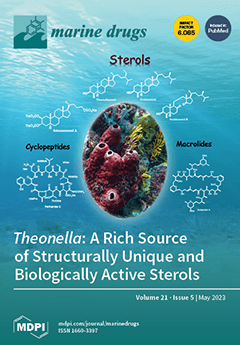Mar. Drugs, Volume 21, Issue 5 (May 2023) – 59 articles
Theonella spp. sponges represents an arsenal of novel compounds, including peptides, macrolides, and sterols. This review provides a compilation of the literature on sterols isolated from this amazing sponge, focusing on their unique structural features, peculiar biological activities, and chemical modifications. They have showed pharmacological activities, such as anticancer, antimicrobial, and, more recently, modulatory action towards different nuclear receptors, making them the first marine compounds able to modulate pharmacological targets. The investigation of natural metabolite libraries reaffirms the utility of study of marine organisms for the discovery of new therapeutical approaches to treating human diseases. View this paper
- Issues are regarded as officially published after their release is announced to the table of contents alert mailing list.
- You may sign up for e-mail alerts to receive table of contents of newly released issues.
- PDF is the official format for papers published in both, html and pdf forms. To view the papers in pdf format, click on the "PDF Full-text" link, and use the free Adobe Reader to open them.






